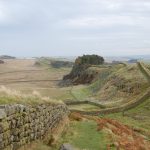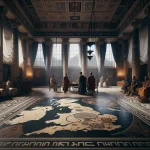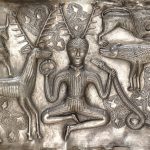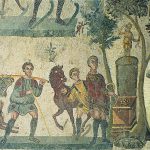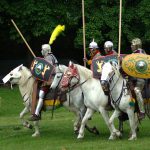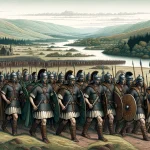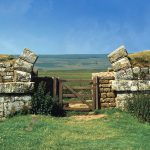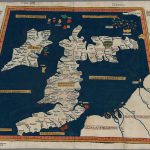Penkridge (Pennocrucium) Roman Burg
Roman Burg
The Civilian Settlement of Pennocrucium /Pennocrvcivm – At Stretton Bridge [42 JRS XXXIX, 1949, 102] (SJ 907107) in Staffordshire, a rectangular enclosure astride Watling Street has been identified from the air and tested by digging. The dimensions are about 700 ft. from east to west by 450 ft. There are three ditches, two of them broad, and the outermost narrow: on the south side the hollow of the ditches is plainly visible on the ground. No trace has been seen here of a stone rampart or of buildings in stone, and trial-trenches identified only wooden buildings, lightly cobbled lanes, and rubbish-pits. The distance of the site from Wall and from Wroxeter provide good grounds for identifying the place as Pennocrucium. Stretton Bridge is the third rectangular, multiple-ditched enclosure astride a Roman trunk road to be described, the others being Brough and Thorpe on the Fosse Way, while photographs of Mancetter in Warwickshire show a similar site there. These places conform to a pattern, and the rather military design suggested by the shape and the rounded angles poses the question whether they can have begun as military establishments and developed into posting-stations and small roadside towns.” (J.R.S., 1953, p.92)
Position and Dimensions
Pennocrucium straddled Watling Street at Stretton Bridge with the road running along it’s main axis. The defences consisted of a triple ditch system; the outer ditch was V-shaped and rather shallow, 10 ft. wide and 4 ft. deep; the middle ditch, the centre of which lay 25 ft. away, measured 17 ft. wide and 6.5 ft. deep with a rounded bottom due to slippage of the sandy soil; the inner V-shaped ditch was nearly 26 ft. wide and 8 ft. deep. The overall width of the vallation system was 80 ft.
The area enclosed by the ditches measures 425 ft. from North to South, by 620 ft. East to West. No direct evidence was found for either a rampart or some form of palisade, but we may presume that one was present and if a minimum of 20 ft. is allowed for this, the area within the defenses available for occupation would have been about 385 ft. by 580 ft., some 5 acres.
The Area North of Watling Street
Groups of irregular clay and timber buildings stood on the north side of Watling street and were separated into building-blocks by at least three cobbled side lanes between 12-15 ft. wide running at right-angles off the main highway between 80-110 ft. apart. Farther back from Watling Street towards the north margin of the enclosure lay an area of cultivated ground, perhaps gardens and animal pens. The suggestion of a small, fortified settlement with the greatest density of building near the main road is in accordance with these observed facts.
The following coinage evidence was unearthed during excavation of the northern area; a dupondius of Vespasian (69-79 AD), an as of Nerva (96-98 AD), an as of Antoninus Pius (138-161 AD) and a corroded bronze coin, possibly of Hadrian.
Several pieces of Samian ware were found in the northern half of the site; a large, decorated fragment in the style of the QVINTILIANVS-BASSVS group of potters c.125-45 A.D. , an early bowl stamped PATERCLOS.FE (late Trajan-Hadrian) and a dish stamped on it’s base with CURTI.MA (Domitian-Trajan) were both from the Lezoux potteries.
Amongst the coarse pottery finds were; greyware cooking pots, grey-black jars with re-curved rims and lattice decorations, ‘rusticated’ jars in hard blue-grey ware (all early second century). Pink ware fragments included flagons, handled mugs, beakers, heavy storage-jars and amphorae.
The Area South of Watling Street
Excavation of the southern portion of the site revealed more transverse side streets, complete with a cobbled gutter, the central channel being about 18 in. wide and between 6-9 in. deep. At one point a 12 in. square iron grating was laid across the gutter, it was also crossed at two points by small culverts.
The evidence recovered from the southern diggings confirmed the findings on the north side; that the occupation of Pennocrucium lasted from the last quarter of the first century AD till at least the early fourth century, and that small buildings of wattle and daub construction on stone foundations were laid out in a rectangular street plan based on the line of the main road. A scheme of three distinct periods of construction was tentatively suggested, and is detailed below.
Nearly all of the pottery finds in the southern half of the site were coarse ware of various kinds. Undecorated black or grey ware predominated, though red, pink and buff shards were also numerous. There were also several fragments of cream ware, a few of which had a red slip. Castor ware, amphorae, mortaria and Rhenish beakers were also represented. Several fragments of decorated Samian ware were also found which could be dated; two fragments of Flavian origin, one Trajanic and one Hadrianic.
Other finds included small fragments of mostly greenish glass, a bronze brooch of Dolphin type, two bronze studs and two Victories placing shield on Cippus and mint-marked PLN, possibly from Londinium c.320-4AD. Three coins were also found; an as of Antoninus Pius, cos. III (145-61AD), a GENIVS POPVLI ROMANVS type and an ae 17mm dia. marked CONSTANTINVS MAX AVG, sporting a bust of Constantine I, helmeted and cuirassed.
The Fortified Burg
The plan and triple ditch system of the defenses recall Roman military practice but the profile of the ditches, lacking drainage channels is not of characteristically military standards. Also, in a fort of this size it would be normal for there to be a gate in each of the four sides, but at Pennocrucium there are only three; two gates in the east and west sides on the line of Watling Street, and a third in the southern defences, admitting the road to Greensforge.
Pennocrucium was possibly built by Roman legionaries specifically to defend a civil settlement which developed at the conjunction of several Roman roads. The layout of the timber buildings of the first period of occupation do not conform to the standardized structures present in a military fort, and no finds of a distinctly military nature have been found within it’s boundaries.
During the Hadrianic period, the buildings on the site were of timber and clay construction with plastered clay and cobble floors, the roofs of which were mainly of baked red clay tiles secured with iron nails, though some were roofed by sandstone tiles. A few buildings had thatched roofs weighted down with baked clay weights and ropes. Streets paved with large cobbles separated the buildings, and stone guttering complete with iron gratings and culverts provided drainage.
An Important Roman Road Junction
The course of Watling Street runs from east to west directly through the centre of the civil settlement. This important military highway arrived from Letocetum (Lichfield) sixteen miles away to the east, and exited heading due west to Uxacona (Redhill), a further twelve miles, then on to it’s north-western terminus at Viroconium Cornoviorum (Wroxeter) twenty-three miles from Pennocrucium.
Another military road ran south thirty-two miles to the Roman town of Salinae (Droitwich), via the complex of forts at Greensforge, which lay exactly half the distance between the two settlements. There is a noticable gap in the centre of the southern defences of Pennocrucium where this road entered the settlement.
A further military branch-road led north-west off the Watling Street after its crossing over the River Penk, and ran for thirty-three miles to Mediolanum (Whitchurch). This road was laid after the Legionary Fortress was built at Deva (Chester), and it is possible that a mutatio was set up at this time here, in Pennocrucium.
There are traces of yet another Roman military Road branching off south-east from the Greensforge road about a kilometre south of the settlement, towards the Metchley Fort at Edgbaston in Birmingham, twenty-two miles distant.
There is evidence also, of an ancient iron-age highway nearby which ran parallel and to the south of Watling Street. This track joined the citadel of the Cornovii on the Wrekin with settlements at Brewood (SJ8808) and Crateford (SJ9009), and continued east towards Letocetum (Wall).
Suggested Pennocrucium Timeline
- Winter 47/48AD the large campaign fortress was probably established as a base for a vexillatio of Legio XIV Gemina, by the Roman governor Ostorius Scapula during his march on the Cornovian citadel on the Wrekin.
- Also in the winter of 47/48AD, it is possible that the Auxiliary fort at Eaton House was built to safeguard the retreat of the Fourteenth Legion, following its departure westwards to Burlington in Shropshire.
- Additionally in winter 47/48AD, it is very likely that one or more of the marching camps in the region can be attributed to the build-up of Roman military forces in the Pennocrucium area, prior to the westwards push into Shropshire; possibly Water Eaton Camps #1 and #2 as they lie on the east bank of the Penk.
- It is probable that one or more marching camps to the west of the Penk (Water Eaton Camps #3 to #5) are attributable to Suetonius Paulinus during his drive from Anglesey to counter the Rebellion of Boudicca in East Anglia c.60/61AD.
- c.50AD to 200AD Stretton Mill fort built. The position of this fort on the west bank of the Penk, but defensible against attack from either east or west, suggest that it was built in the aftermath of the Boudiccan revolt. The sparse dating evidence also supports this notion.
- c.80AD to 110AD (Settlement: Period I) Irregularly spaced houses with gravel floors and upright posts with wattle and daub walls.
- c.130AD to 160AD (Settlement: Period II) Buildings with plastered clay and cobble floors, and timber and clay walls were constructed, sometimes over original buildings of the previous period. The gutter and side-street system probably belonged to this period.
- c.195-211AD Original building completed on the Villa site.
- c.270-80AD Second period of building at Villa site.
- c.270AD to 320AD (Settlement: Period III) Fire destroyed buildings of period II which were not rebuilt. Guttering and streets continued in use however. The gratings may have belonged to this period.
Other Pennocrucium Pieces
STRETTON . …- The site of Pennocrucium, the Roman station of the Antonine Itinerary on Watling Street, 12 Roman miles from Uxacona (Oakengates) and 12 from Letocetum (Wall), is generally thought to be here because the distances approximately agree. The name Pennocrucium suggests a connexion with the River Penk which the Watling Street here crosses, and the name of Stretton suggests a Roman site. No Roman coins or other antiquities, however, have been discovered, but no systematic excavations have been attempted. There are two small eminences near the street, called Rowley Hill and Beacon Hill. The larger, Rowley Hill, occupies about five acres, rises from meadows near the river, and is surmounted by a tumulus in which a few iron-age remains have been found [Pitt, Hist. Staffs. i, 260 ; Stebbing Shaw, Hist. Staffs. i, 31 ; Wright, Celt. Rom. Sax. 124 ; Horsley, Brit. Rom. 420 ; MS. Min. Soc. Antiq. i, 203 ; Arch. v, 113 ; Plot, Hist. Staffs. 401].” (V.C.H. Staffs.)
Classical References for Pennocrucium – The End of the Ridge
The only classical geographical reference which contains the Roman name for the Water Eaton area is the Antonine Itinerary of the late-second century. In Iter II, “the route from Hadrian’s Wall to the port of Rutupiae“, the name Pennocrucio is listed 12 miles from Uxacona (Redhill, Shropshire) and 12 miles from Letocetum (Wall, Staffordshire).
The name Pennocrucium is a straight Romanisation of the original name (Welsh/Gaelic) penn-crug meaning ‘the head, or terminus, of the ridge’. This refers to the long ridge of land lying on the eastern bank of the River Penk, upon which the modern town of Penkridge now lies.
The Roman civil settlement of Pennocrucium was identified from the air in 1946 and confirmed by subsequent excavations, which revealed a rectangular enclosure of 2.8 hectares lying astride Watling Street at Water Eaton, between Gailey and the crossing of the River Penk. Traces of three ditches were found, but no evidence of stone buildings or walls. The interior has evidence of wooden structures fronting onto Watling Street, cobbled streets and rubbish pits. Pottery finds range from late first to late third centuries, with the possibility of two occupation periods, the latest being from the late second century. A causeway through the south side of the defenses marks the entrance of the road from Greensforge.
Pennocrucium is likely the site of a Roman Imperial way station or Mutationes (from Latin mutatio: changing, exchange), where persons on official business could obtain a change of horses before continuing on to the next locus in their itinerary.
References for Pennocrvcivm
- Air Reconnaissance in Britain, 1961-1964 by J.K. St. Joseph in J.R.S. lv (1965) pp.76/7 & fig.3; Victoria County History – Staffordshire vol.I, pp.192-3;
- The Roman Site Near Stretton Bridge, the Ancient Pennocrucium by J.K. St. Joseph in B.A.S. Trans. 1953? pp.1-5;
- Further Investigations at Pennocrucium near Stretton Bridge, 1953-4 by I.M. Barton in B.A.S. Trans. 1955 pp.6-9;
- Air Reconnaissance of Southern Britain by J.K. St. Joseph in J.R.S. xliii (1953) pp.81-97;
- Road Widening at Pennocrucium in 1956; a Note by Graham Webster in B.A.S. Trans. 1957 pp.10/11;
Map References for Pennocrvcivm
NGRef: SJ90251071 OSMap: LR127
Roman Roads near Pennocrvcivm
Watling Street/Iter II: W (7) to Bvrlington S (13) to Greensforge (South Staffordshire) Watling Street/Iter II: E (13) to Letocetvm (Wall, Staffordshire) NW (30) to Mediolanvm Probable tactical road: SE (22) to Metchley (Metchley, Birmingham) Watling Street: W (11) to Uxacona (Redhill, Shropshire)
Sites near Penkridge (Pennocrucium) Roman Burg
- Eaton House (Pennocrucium) Roman Fort (0 km)
Auxiliary Fort - Water Eaton (Kinvaston) 2 Temporary Camp (0 km)
Marching or Temporary Camp - Water Eaton (Stretton Mill) 4 Temporary Camp (1 km)
Marching or Temporary Camp - Water Eaton (Stretton Mill) 3 Temporary Camp (1 km)
Marching or Temporary Camp - Water Eaton (Stretton Mill) 5 Temporary Camp (1 km)
Marching or Temporary Camp - Stretton Mill Roman Fort (1 km)
Auxiliary Fort - Kinvaston Fort (1 km)
Vexillation Fort - Engleton Villa (1 km)
Villa - Berry Ring (11 km)
Iron Age Hillfort - Burlington 1 Temporary Camp (12 km)
Marching or Temporary Camp
